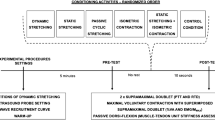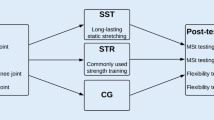Abstract
Stretching in the warm-up was been shown to decrease several muscular performance variables, but the dose-response of this effect is unknown. This study documented the change in isometric grip strength over ten trials in a convenience sample of young adults randomly assigned to control (n=22) or repeated bouts of 10-s static stretches of the wrist flexors (n=35). There was a significant (P<0.05) difference in the change in mean normalized grip strength between the control and stretching groups that was not significantly different across gender. Grip strengths in the control group were consistent with a linear trend, while the grip strengths in the stretching group declined in a logarithmic fashion to 88.8% with 100 s of stretching. Statistically significant (P<0.05) differences in normalized grip strength between the two groups appeared after 40 s of stretching. Meaningful decreases in isometric grip strength following static stretching are likely to appear in young adults following 20–40 s of static stretching.

Similar content being viewed by others
References
Avela J, Kyrolainen H, Komi PV (1999) Altered reflex sensitivity after repeated and prolonged passive muscle stretching. J Appl Physiol 86:1283–1291
Cornwell A, Nelson AG, Heise GD, Sidaway B (2001) Acute effects of passive muscle stretching on vertical jump performance. J Hum Mov Stud 40:307–324
Dunwoody L, Tittmar HG, McClean WS (1996) Grip strength and intertrial rest. Percept Mot Skills 83:275–278
Dvir Z (1999) Coefficient of variation in maximal and feigned static and dynamic grip efforts. Am J Phys Med Rehabil 78:216–221
Evetovich TK, Nauman NJ, Conley DS, Todd JB (2003) Effect of static stretching of the biceps brachii on torque, electromyography, and mechanomyography during concentric isokinetic muscle actions. J Strength Cond Res 17:484–488
Fowles JR, Sale DG, MacDougall JD (2000) Reduced strength after passive stretch of the human plantar flexors. J Appl Physiol 89:1179–1188
Hamilton-Fairfax A, Balnave R, Adams RD (1995) Variability of grip strength during isometric contraction. Ergonomics 38:1819–1830
Knudson D, Bennett K, Corn R, Leick D, Smith C (2001) Acute effects of stretching are not evident in the kinematics of the vertical jump. J Strength Cond Res 15:98–101
Knudson D, Noffal G, Bahamonde R, Bauer J, Blackwell J (2004) Stretching has no effect on tennis serve performance. J Strength Cond Res 18:654–656
Koch AJ, O’Bryant HS, Stone ME, Sanborn K, Proulx C, Hruby J, Shannonhouse E, Boros R, Stone M (2003) Effect of warm-up on the standing broad jump in trained and untrained men and women. J Strength Cond Res 17:710–714
Kokkonen J, Nelson AG, Cornwell A (1998) Acute muscle stretching inhibits maximal strength performance. Res Q Exerc Sport 69:411–415
Magnusson SP (1998) Passive properties of human skeletal muscle during stretch maneuvers: a review. Scand J Med Sci Sports 8:65–77
Magnusson SP, Simonsen EB, Aagaard P, Kjaer M (1996) Biomechanical responses to repeated stretches in human hamstring muscle in vivo. Am J Sports Med 24:622–628
Mathiowetz V, Kashman N, Vollard G, Weber K, Dowe M, Rogers S (1985) Grip and pinch strength: normative data for adults. Arch Phys Med Rehabil 66:69–74
McNeal JR, Sands WA (2003) Acute static stretching reduces lower extremity power in trained children. Pediatr Exerc Sci 15:139–145
Nelson AG, Kokkonen J (2001) Acute ballistic muscle stretching inhibits maximal strength performance. Res Q Exerc Sport 72:415–419
Nelson AG, Allen JD, Cornwell A, Kokkonen J (2001) Inhibition of maximal voluntary isometric torque production by acute stretching is joint-angle specific. Res Q Exerc Sport 72:68–70
Petrofsky JS, Williams C, Kamen G, Lind AR (1980) The effect of handgrip span on isometric exercise performance. Ergonomics 23:1129–1135
Reddon JR, Stefanyk WO, Gill DM, Renney C (1985) Hand dynamometer: effects of trials and sessions. Percept Mot Skills 61:1195–1198
Richards L, Palmiter-Thomas P (1996) Grip strength measurement: a critical review of tools, methods, and clinical utility. Crit Rev Phys Rehabil Med 8:87–109
Rosenbaum D, Hennig E (1995) The influence of stretching and warm-up exercises on achilles tendon reflex activity. J Sport Sci 13:481–490
Taylor DC, Dalton JD, Seaber AV, Garrett WE (1990) Viscoelastic properties of muscle-tendon units. Am J Sports Med 18:300–309
Thigpen LK (1989) Effect of statically performed toe touch stretches on torque production of the hamstring and quadriceps muscles groups. J Hum Mov Stud 17:71–88
Trossman PB, Li PW (1989) The effect of duration of intertribal rest periods on isometric grip strength performance in young adults. Occup Ther J Res 9:362–378
Young WB, Behm DG (2003) Effects of running, static stretching and practice jumps on explosive force production and jumping performance. J Sports Med Phys Fit 43:21–27
Young W, Clothier P, Otago L, Bruce L, Liddell D (2004) Acute effects of static stretching on hip flexor and quadriceps flexibility, range of motion and foot speed in kicking a football. J Sci Med Sport 7:23–31
Author information
Authors and Affiliations
Corresponding author
Rights and permissions
About this article
Cite this article
Knudson, D., Noffal, G. Time course of stretch-induced isometric strength deficits. Eur J Appl Physiol 94, 348–351 (2005). https://doi.org/10.1007/s00421-004-1309-9
Received:
Accepted:
Published:
Issue Date:
DOI: https://doi.org/10.1007/s00421-004-1309-9




